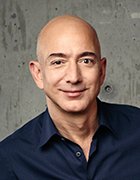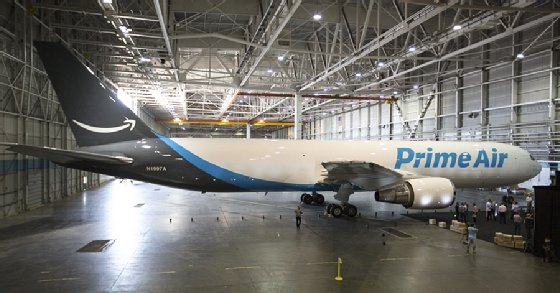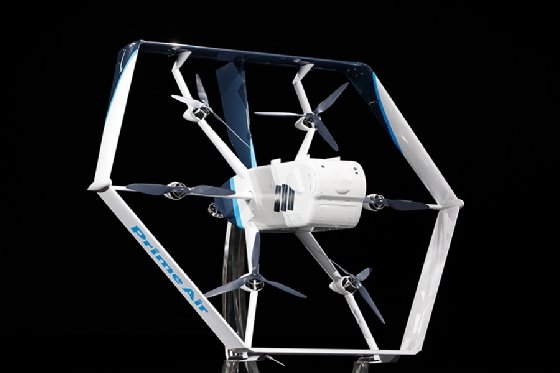Amazon bets big on last mile delivery service improvements
Amazon has made a significant investment in building out its last mile delivery services to grab a piece of the growing grocery delivery market.
For years, Amazon CEO Jeff Bezos has had a laser focus on eliminating any and all issues relating to customer service, something he believes is crucial to the company's lavish success. But once a package left one of Amazon's cavernous warehouses, the company had little control over the quality of that last mile of service.
Amazon took matters into its own hands about two years ago and invested heavily in developing its own delivery channels as a way to ensure better quality control right to consumers' doorsteps. Those investments, involving electric-powered delivery vans, drones, sidewalk robots and partnerships with third parties, have met with varying degrees of success.
 Jeff Bezos
Jeff Bezos
The demand for Amazon delivery services from its e-commerce site and Whole Foods has skyrocketed during the COVID-19 pandemic as consumers seek ways to get goods without leaving their homes.
While some delivery methods are too new to pass judgement on, what's certain is that Amazon's delivery service strategy is sure to have ripple effects across the supply chain and transportation industry.
The cost of Amazon's last mile delivery investments
There appear to be an abundance of financial opportunities that could make Amazon's delivery service investments worthwhile.
In 2018, overall revenue for the last mile delivery market in North America was $31.25 billion, and it is expected to grow to about $51 billion by 2022, according to market researcher Statistica in a report issued early this year. Underscoring just how big of a financial impact last mile revenues have on the overall economy, the Bureau of Economic Analysis (BEA) reported the last leg of overall transportation costs make up 28% of overall logistics expenses. Adding to that, the Bureau of Transportation Statistics said last mile goods and services purchased by businesses and government in 2018 made up $1.48 billion, or 8.9%, of the U.S. GDP.
But when the 28% BEA figure is applied to the latter number, "the market for final mile (from a GDP perspective) is a whopping $417 billion," according to a recent report by the BEA.
Amazon's investment to maintain its lead in the last mile delivery market, however, is becoming increasingly expensive. In its third quarter earnings report the company said it invested $1.5 billion in its one-day delivery initiative, which company officials said they hope will replace two-day Amazon Prime membership program. The $1.5 billion figure is twice what the company spent in last year's second quarter. Then, in its fourth quarter call, Amazon said it spent another $1.5 billion on its one-day delivery initiative with plans to spend another $1 billion in this year's first quarter on the program.

Amazon estimated its shipping costs for the holiday quarter ending December 31 would surpass $10 billion, driving up its yearly costs to $35 billion for 2019. This is on top of the cost of adding 100,000 people to support the one-day delivery program.
Just as Amazon's move to two-day delivery pushed competitors like Walmart and Target to initiate their own programs, so too has Amazon's one-day delivery program forced competitors to respond. Walmart introduced its one-day delivery program for over 200,000 different items as long as each order exceeds $35. Target bought Shipt in 2017, which specializes in same-day delivery, and has continued to expand programs that better customize their same-day service or ways to lower the cost of that service.
Amazon's ace in the hole
One advantage Amazon holds over both Target and Walmart is that it can draw on capital from its other businesses, most notably its AWS cloud services where profit margins are significantly higher than those from its other e-commerce businesses. The other advantage Amazon holds in the last mile delivery is what has made it, well, Amazon: Bezos is unafraid to quickly cobble together adventurous new delivery programs, and if one doesn't work, just as quickly introduce another -- something Walmart and Target have yet to do.
"The bottom line is even if competitors out-innovate Amazon in this area, they are fast followers and have the money to catch up," said one New York-based retail consultant who has worked for Amazon and requested anonymity. "And once they do, they still find ways to apply new competitive pressures and can turn the tables and force those same competitors to react to them," he said.
Amazon last year furthered bolstered its late mile delivery business by establishing a small and medium-size program that allows anyone to operate their own package delivery fleet. It also launched an Uber-like delivery program for next-day orders.
"This is how they [Amazon] are able to do one-day shipping, by doing more of it themselves as well as hiring contractors," said Thomas O'Connor, senior director and analyst in Gartner's Supply Chain Industries practice. "But when you have contractors who are part of your last mile delivery network, it adds in new challenges around managing them. You may be getting your deliveries to your doorstep one day faster, but are customers getting the same quality of service they get with [full-time] Amazon drivers?"
O'Connor and other analysts have heard scattered reports among some dissatisfied customers, which is not surprising given the enormity of delivering such a service nationwide. He added that such complaints are to be expected, given the ambitious nature of the program.
"But the question now is, are those complaints accelerating or decelerating," O'Connor said. "From what I gather recently, they are not accelerating, so this is a positive for them."
Another analyst believes Amazon's one-day delivery program could be a case of the company's reach exceeding its grasp, and that any deterioration in quality of service is a problem the company brought on itself. Amazon has created an "unintended monster" in attempting to convince consumers and businesses they should be able to get almost anything they want delivered to their house and within two hours, said Guy Courtin, former vice president of industry strategy at Infor, who finds this idea completely artificial.
"There is so much pressure from Bezos on down to meet these crazy SLAs for delivery," Courtin said. "You know it's a bit much when you hear horror stories of drivers peeing in bottles so they don't lose time. Amazon realizes now that matching the expectations they set is very different than promising them."
Months before Amazon's one-day delivery program launched last year, the company may have tipped its hand about how aggressive it intended to be when in 2018 it purchased some 20,000 Mercedes Benz Sprinter vans, a number of which are electric. Such a large a purchase was not only intended to strengthen its last mile delivery capabilities but also be used as a way to generate more revenues via third parties, O'Connor said.
"The reality is they are utilizing themselves as their first customer just as they did with Amazon Web Services," O'Connor said. "But what will be interesting to see is once they get to an efficient enough level, will they sell any additional space in all those vehicles to other retailers? I'm sure that's on their roadmap because they have a clear record of using that strategy."
Food delivery service comes at high cost
Perhaps the most lucrative business for last mile deliveries is food, not just for Amazon, given its ties to Whole Foods, but for the Walmart Online Grocery service and Target's grocery business as well. Analysts believe all three, particularly Amazon, are focusing hard on groceries because it is one of the few areas in retail where you can have multiple orders per week. This, in turn, creates a certain level of standardization for delivery and touchpoints. Consequently, these companies can get a better handle on what volumes they are dealing with and can then tag onto that other types of delivery services.
But the cost of entry to this business isn't cheap. In a recent report, Capgemini Research Institute wrote that today's last mile delivery models are not sustainable. The report contained a survey that found 40% of respondents took frequent advantage of food delivery services every week. The cost of providing last mile services accounted for 41% of the overall supply chain costs, which is double any other category including warehousing and parceling, according to the report.
Capgemini counseled that retailers must examine more closely the supply chain cost per item and not per bulk unit anymore. The report noted that the drop in Target's gross margin in the third quarter 2018 to 28.7%, much lower than anticipated, was due to the cost of fulfillment for web-based sales.
Walmart's grocery business has largely relied on several third-party delivery partnerships including those with Point Pickup and DoorDash. One delivery partner, Skipcart, will end its deal with Walmart this month, following in the footsteps of Uber, due to the inability to profit from Walmart deliveries, according to reports. Still, at the end of last year, Walmart Grocery had 3,100 pickup locations and 1,600 stores that partnered with the company on grocery delivery.
One new last mile delivery approach -- that won't do much to encourage personal relationships with consumers -- is Walmart's deal with Nuro where the two companies have begun an autonomous vehicle grocery delivery service to selected Walmart customers in the Houston area with plans to significantly expand throughout this year the course of 2020.
Drone delivery a dream deferred
What was anticipated to be an integral last mile delivery service a few years ago for food and a wide assortment of other products, delivery drones has stalled. The biggest roadblocks to widespread use in the U.S. are the restrictions placed on drones by the Federal Aviation Administration (FAA), mostly having to do with line-of-sight issues with commercial aircrafts. In Europe and China, where there are fewer restrictions, some companies are in the early stages of launching commercial businesses.
"This is a huge hurdle for Amazon and competitors attempting last-mile fulfillment in the U.S.," O'Connor said. "But they are starting to get into that business in Europe and China. One company making some headway with drones over there is DHL," he said.
Amazon debuted early trials for its Amazon Prime Air service in Cambridge, England in 2016 but had only two beta customers at the time. In March 2015 the FAA gave Amazon permission to begin testing a prototype and it began testing a prototype along the U.S.-Canadian border also in 2016. Assuming it gained full FAA approval, Amazon had expected the drone delivery service to begin operations in late 2019, but the service has yet to launch.
U.S. regulations currently limit drones to flying no higher than 400 feet and not faster than 100 mph. They also must remain within a pilot's line of sight. Amazon officials in the past said their goal for Prime Air drones would be to fly above 200 ft and below 500 ft. The company said its drones would carry packages weighing up to 55 lbs. and travel within a radius of 10 miles from its distribution centers.

If the FAA, Amazon and its competitors can work things out with drone-based delivery services, Courtin believes there is a rich opportunity waiting to be pursued mainly in heavily populated urban areas such as New York.
"When I am in New York I'm struck by the number of large trucks double-parking on narrow streets, tying up traffic for blocks," Courtin said. "Amazon could drive trucks to their large distribution center in Staten Island and from there launch drones to carry packages in the last two miles. They could also restrict flying times from midnight to 5:00 am to reduce the possibility of incidents with aircraft."
To make that work, corporate users, as well as consumers living is large apartment complexes, could build drone airports on their respective rooftops where packages can be delivered to individual mailboxes, Courtin added.
Another potential opportunity for drone services would be in delivering much-needed medical equipment or prescription drugs to people in remote islands offshore where there is likely to be less commercial air traffic.
"Local pharmacists could order medications and get the delivered via a more reliable delivery service than they currently have," Courtin said. "It's an interesting use case people should be thinking more seriously about."
For now, delivery drones and their necessary urban infrastructure remain a dream deferred.
Amazon officials did not respond to requests for comment.







